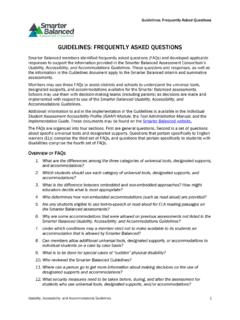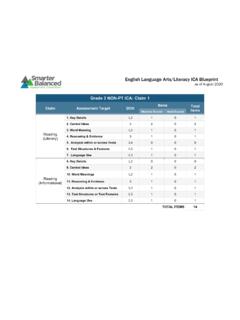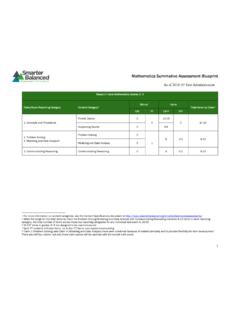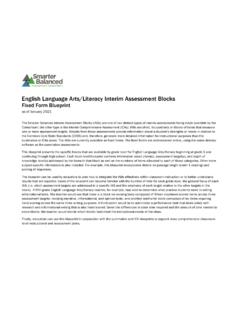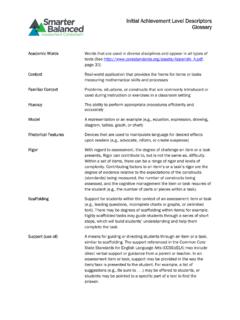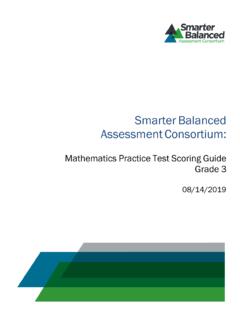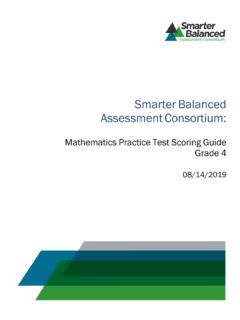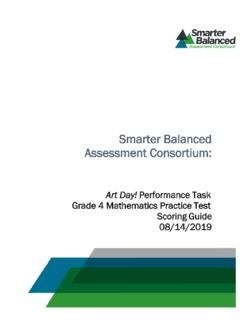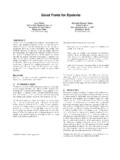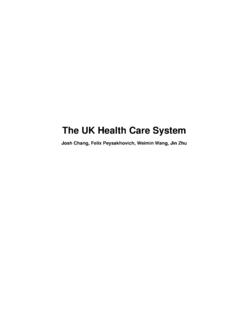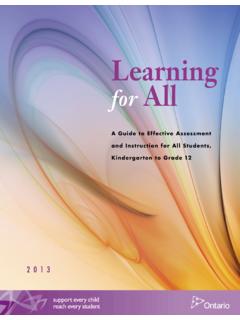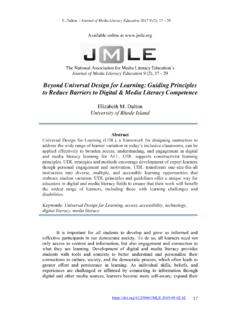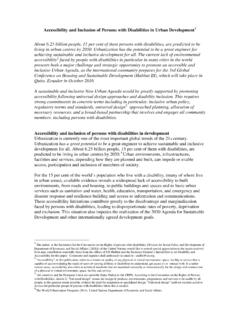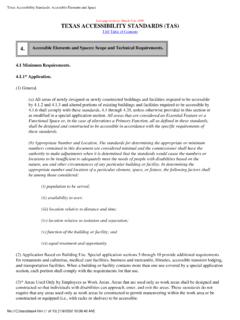Transcription of Smarter Balanced Assessment Consortium
1 Smarter Balanced Assessment Consortium : Usability, accessibility , and Accommodations Guidelines Prepared with the assistance of the National Center on Educational Outcomes June 30, 2020 Usability, accessibility , and Accommodations Guidelines Usability, accessibility , and Accommodations Guidelines ii TABLE OF CONTENTS TABLE OF CONTENTS .. ii Introduction .. 4 Intended Audience and Recommended Use .. 5 Smarter Balanced Assessment Design .. 5 Recognizing Access Needs in All Students .. 5 Structure of This Document .. 8 Section I: Smarter Balanced universal Tools.
2 9 What Are universal Tools? .. 9 Embedded universal Tools .. 9 Non-embedded universal Tools .. 11 Section II: Smarter Balanced Designated Supports .. 13 What Are Designated Supports? .. 13 Who Makes Decisions About Designated Supports? .. 13 Embedded Designated Supports .. 13 Non-embedded Designated Supports .. 17 Section III: Smarter Balanced Accommodations .. 22 What Are Accommodations? .. 22 Who Makes Decisions About Accommodations? .. 22 Embedded Accommodations .. 23 Non-embedded Accommodations .. 25 Resources .. 29 Appendix A: Summary of Smarter Balanced universal Tools, Designated Supports, and Accommodations.
3 30 Appendix B: Research-based Lessons Learned about universal Design, accessibility Tools, and Accommodations .. 32 Who might benefit from accessibility features identified by AA-MAS research? .. 32 What changes can be made to test items and tests that do not change the construct being assessed? .. 32 What can test developers do to build on the lessons learned from AA-MAS research and implementation? .. 33 Appendix C: Frequently Asked Questions .. 35 Overview of FAQs .. 35 General FAQs .. 37 universal Tools and Designated Supports FAQs (Available to All Students).
4 44 Usability, accessibility , and Accommodations Guidelines Usability, accessibility , and Accommodations Guidelines iii FAQs Pertaining to English Learners (ELs) .. 45 FAQs Pertaining to Students with Disabilities .. 47 Appendix D: Read Aloud Guidelines .. 50 Images/Graphics/Diagrams/Tables .. 56 From top to bottom .. 56 From left to right .. 57 Clockwise (Start wherever makes sense.) .. 57 Tables .. 58 Appendix E: Scribing Protocol for Smarter Balanced Assessments .. 61 Considerations for students also using ASL or other sign system .. 64 Appendix F: Revision Log.
5 66 Usability, accessibility , and Accommodations Guidelines Usability, accessibility , and Accommodations Guidelines 4 INTRODUCTION The Smarter Balanced Assessment Consortium ( Smarter Balanced ) strives to provide every student with a positive and productive Assessment experience, generating results that are a fair and accurate estimate of each student s achievement. Further, Smarter Balanced is building on a framework of accessibility for all students, including English Learners (ELs), students with disabilities, and ELs with disabilities, but not limited to those groups.
6 In the process of developing its next-generation assessments to measure students knowledge and skills as they progress toward college and career readiness, Smarter Balanced recognized that the validity of Assessment results depends on each and every student having appropriate universal tools, designated supports, and accommodations when needed based on the constructs being measured by the Assessment . This document was developed for the Smarter Balanced members to guide the selection and administration of universal tools, designated supports, and accommodations.
7 The Smarter Balanced Assessment is based on the Common Core State Standards (CCSS). Thus, the universal tools, designated supports, and accommodations that are appropriate for the Smarter Balanced Assessment may be different from those that members allowed in the past. For the secure summative assessments, a member can only make available to students the universal tools, designated supports, and accommodations that are included in the Smarter Balanced Usability, accessibility , and Accommodations Guidelines (UAAG). A member may elect not to make available to its students any universal tool, designated support, or accommodation that is otherwise included in the Guidelines when the implementation or use of the universal tool, designated support, or accommodation is in conflict with a member s law, regulation, or policy.
8 These Guidelines describe the Smarter Balanced universal tools, designated supports, and accommodations available for the Smarter Balanced assessments at this time (see Appendix A). The specific universal tools, designated supports, and accommodations approved by Smarter Balanced may change in the future if additional tools, supports, or accommodations are identified for the assessments based on member experience and research findings. The Consortium has established a standing committee, including representatives from Governing members that review suggested additional universal tools, designated supports, and accommodations to determine whether changes are warranted.
9 Proposed changes to the list of universal tools, designated supports, and accommodations are brought to Governing members for review, input, and vote for approval. Furthermore, members may issue temporary approvals ( , one summative Assessment administration) for individual unique student accommodations or designated supports. K-12 leads will evaluate formal requests for unique accommodations/designated supports and determine whether or not the request poses a threat to the measurement of the construct. Upon issuing a temporary approval, the member will send documentation of the approval to the Consortium .
10 The Consortium will consider all member-approved temporary accommodations/designated supports as part of the annual Consortium UAAG review process. If the Consortium determines it requires additional time to study the issue before the Consortium can engage in a vote, a member may notify the Consortium that the member intends to issue temporary approvals for the same accommodation/designated support during the next summative Assessment administration. Members should include in their notification to the Consortium the intended use of the temporary accommodation/support and the rationale for issuing temporary authorizations for the next summative Assessment administration.
